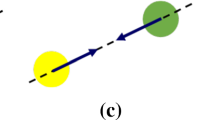Abstract
In this paper, we provide a full instruction on how to formulate and evaluate planar frictional contact problems in the spirit of non-smooth dynamics. By stating the equations of motion as an equality of measures, frictional contact reactions are taken into account by Lagrangian multipliers. Contact kinematics is formulated in terms of gap functions, and normal and tangential relative velocities. Associated frictional contact laws are stated as inclusions, incorporating impact behavior in form of Newtonian kinematic impacts. Based on this inequality formulation, a linear complementarity problem in standard form is presented, combined with Moreau’s time stepping method for numerical integration. This approach has been applied to the woodpecker toy, of which a complete parameter list and numerical results are given in the paper.
Similar content being viewed by others
References
Alart, P. and Curnier, A. A mixed formulation for frictional contact problems prone to Newton like solution methods. Computer Methods inApplied Mechanics and Engineering 92(3), 1991, 353–357.
Anitescu, M., Potra, F.A. and Stewart, D.E. Time-stepping for three-dimensional rigid body dynamics. Computer Methods inApplied Mechanics and Engineering 177(3), 1999, 183–197.
Cottle, R.W., Pang, J.S. and Stone, R.E. The Linear Complementarity Problem, Computer Science and Scientific Computing, Academic Press, London, 1992.
Curnier, A., He, Q.C. and Klarbring, A. Continuum mechanics modelling of large deformation contact with friction, in Contact Mechanics, Raous, M., Jean, M. and Moreau, J.J. (eds.), Plenum Press, New York, 1995, 145–158.
Elstrodt, J., Maßund Integrationstheorie, Springer Verlag, Berlin, 1996.
Facchinei, F., Fischer, A. and Kanzow, Ch. A semismooth Newton method for variational inequalities: The case of box constraints, in Complementarity and Variational Problems: State of the Art, Ferris, M.C. and Pang, J.-S. (eds.), SIAM, Philadelphia, 1997, 76–90.
Glocker, Ch. Dynamik von Starrkörpersystemen mit Reibung und Stößen. VDI-Fortschrittberichte Mechanik/Bruchmechanik, Reihe 18, Nr. 182, VDI-Verlag, Düsseldorf, 1995.
Glocker, Ch. Set-Valued Force Laws: Dynamics of Non-Smooth Systems, Springer Verlag, Berlin Heidelberg, 2001.
Jean, M. The non-smooth contact dynamics method. Computer Methods in Applied Mechanics Engineering 177, 1999, 235–257.
Klarbring, A. Mathematical programming and augmented Lagrangian methods for frictional contact problems. Proceeding on Contact Mechanics International Symposium, Lausanne, 1992, 409–422.
Leine, R.I., Glocker, Ch. and van Campen, D.H. Nonlinear dynamics and modeling of various wooden toys with impact and friction. Journal of Vibration and Control 9, 2003, 25–78.
Moreau, J.J. Unilateral contact and dry friction in finite freedom dynamics, in Non-Smooth Mechanics and Applications, Moreau, J.J. and Panagiotopoulos, P.D. (eds.), CISM Courses and Lectures, Vol. 302, Springer Verlag, Wien, 1988, 1–82.
Moreau, J.J. Bounded variation in time, in Topics in Nonsmooth Mechanics Moreau, J.J. Panagiotopoulos, P.D. and Strang, G. (eds.), Birkhäuser Verlag, Basel, 1988, 1–74.
Moreau, J.J., Numerical aspects of the sweeping process. ComputerMethods in Applied Mechanics. Engineering. 177, 1999, 329–349.
Murty, K.G. Linear Complementarity, Linear and Nonlinear Programming (Sigma Series in Applied Mathematics), Vol. 3, Heldermann Verlag, Berlin, 1988.
Panagiotopoulos, P.D. A nonlinear programming approach to the unilateral contact-, and friction-boundary value problem in the theory of elasticity. Ingenieur-Archiv 44, 1975, 421–432.
Pang, J.S. and Trinkle, J.C. Complementarity formulations and existence of solutions of dynamic multi-rigid-body contact problems with Coulomb friction. Mathematical Programming 30, 1996, 199–226.
Paoli, L. and Schatzman, M. A Numerical scheme for impact problems I: The one-dimensional case. SIAM Journal on Numerical Analysis 40(2), 2002, 702–733.
Paoli, L. and Schatzman, M. A Numerical scheme for impact problems II: The multidimensional case. SIAM Journal on Numerical Analysis 40(2), 2002, 734–768.
Pfeiffer, F. and Glocker, Ch. Multibody Dynamics with Unilateral Contacts, Wiley, New York, 1996.
Rudin, W.Real and Complex Analysis,Tata McGraw-Hill, New Delhi, India, 1981.
Stewart, D.E. and Trinkle, J.C. An implicit time-stepping scheme for rigid body dynamics with inelastic collisions and Coulomb friction. International JournalNumericalMethods Engineering 39(15), 1996, 2673–2691.
Stewart, D.E. Convergence of a time-stepping scheme for rigid body dynamics and resolution of Painlevé’s problem. Archives of Rational Mechanics and Analysis 145, 1998, 215–260.
Author information
Authors and Affiliations
Corresponding author
Rights and permissions
About this article
Cite this article
Glocker, C., Studer, C. Formulation and Preparation for Numerical Evaluation of Linear Complementarity Systems in Dynamics. Multibody Syst Dyn 13, 447–463 (2005). https://doi.org/10.1007/s11044-005-2519-6
Received:
Accepted:
Issue Date:
DOI: https://doi.org/10.1007/s11044-005-2519-6




